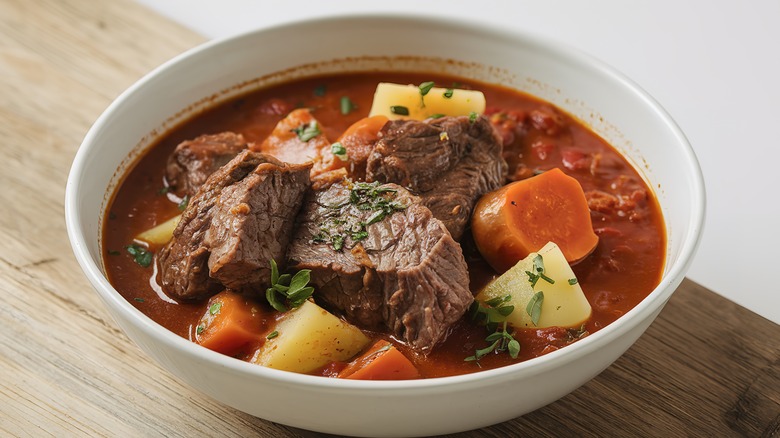The Worst Timing Mistake You Can Make When It Comes To Beef Stew
Beef stew is a classic comfort dish. There's nothing quite like a warm bowl of it accompanied by a slice of crusty bread on a cozy evening at home. However, this definitely isn't a dish you're going to impulsively decide to whip up on a busy weeknight — unless you plan on eating at midnight, that is. There are many mistakes to avoid when cooking beef stew, with the correct timing of adding ingredients being a major one. Beef stew takes time to get right, and adding the various ingredients at the right intervals is critical to the success of your stew.
If you're in a hurry and need to get something on the table quickly, just don't even attempt to make beef stew. Save it for another day, because rushing this dish won't be worth it. If you add all your vegetables into a pot at the same time as your meat, you run the risk of severely overcooking the veggies and ending up with a mushy mess. Adding the vegetables in too early can prevent the meat from browning enough to get that desirable exterior crust or simmering long enough in the broth for a tender interior. This can result in beef that is tough and chewy, instead of having that slow-cooked, melt-in-your-mouth quality that makes beef stew so comforting.
Getting the timing perfect
The first step is to properly sear your whole cut of beef in a skillet. Browning meat in a piping-hot pan causes a chemical reaction (called the Maillard reaction) that, simply put, just makes the beef taste better. While you can certainly chop up the beef into cubes first, this can cause moisture to escape from your meat, which leads to less juicy bite-sized pieces in the finished product. If you can, sear the whole chunk of beef on all sides until it's nicely browned and smells amazing. Depending on the size of the cut, this step will take between 5 and 10 minutes. Do not add any other ingredients (besides a bit of oil) during this step. Your meat needs to have the skillet to itself, and adding any veggies will cause them to become overcooked.
You can cube your meat once it's properly seared. You must continue to resist the urge to add any vegetables, because it's still not time yet. Your browned, cubed meat now needs to simmer in your broth, wine, beer, or whatever liquid combination you are using for about one hour per every pound of meat you have. So, if you have a two-pound chuck roast, you need to let it simmer on low heat for about two hours. Once it's fork-tender, you may finally toss in the vegetables. Potatoes and carrots are regulars in beef stew, and they will need about another hour to cook before dinner is finally ready. Save some for another evening by ensuring you are freezing it the right way. Having the patience to get the timing exactly right may seem tedious, but it is worth it when it results in a perfect bowl of beef stew.

